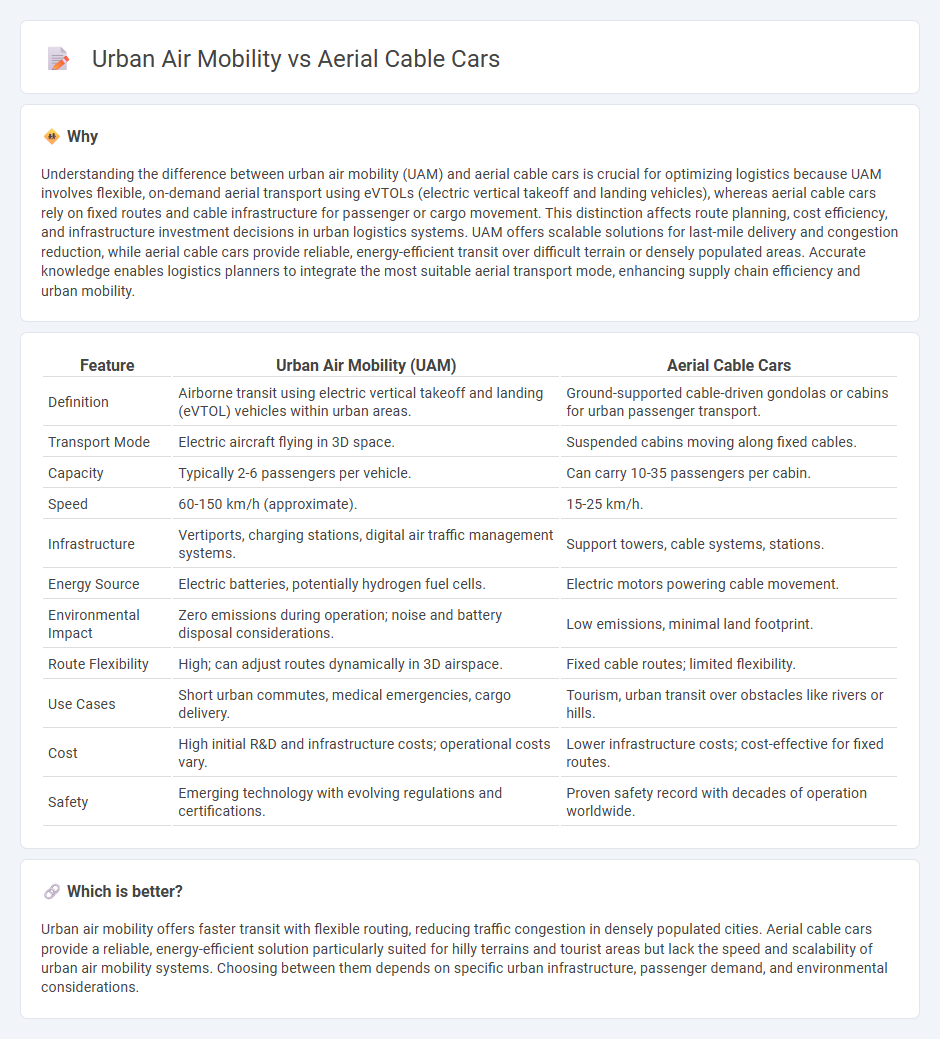
Urban air mobility (UAM) revolutionizes city logistics by deploying electric vertical takeoff and landing (eVTOL) aircraft to alleviate ground traffic congestion and enable rapid passenger and cargo transport. Aerial cable cars serve as a proven, energy-efficient solution for short-distance urban transit, particularly effective in challenging terrains and densely populated areas. Explore the distinctive benefits and applications of these innovative urban transportation models to understand their impact on future logistics.
Why it is important
Understanding the difference between urban air mobility (UAM) and aerial cable cars is crucial for optimizing logistics because UAM involves flexible, on-demand aerial transport using eVTOLs (electric vertical takeoff and landing vehicles), whereas aerial cable cars rely on fixed routes and cable infrastructure for passenger or cargo movement. This distinction affects route planning, cost efficiency, and infrastructure investment decisions in urban logistics systems. UAM offers scalable solutions for last-mile delivery and congestion reduction, while aerial cable cars provide reliable, energy-efficient transit over difficult terrain or densely populated areas. Accurate knowledge enables logistics planners to integrate the most suitable aerial transport mode, enhancing supply chain efficiency and urban mobility.
Comparison Table
| Feature | Urban Air Mobility (UAM) | Aerial Cable Cars |
|---|---|---|
| Definition | Airborne transit using electric vertical takeoff and landing (eVTOL) vehicles within urban areas. | Ground-supported cable-driven gondolas or cabins for urban passenger transport. |
| Transport Mode | Electric aircraft flying in 3D space. | Suspended cabins moving along fixed cables. |
| Capacity | Typically 2-6 passengers per vehicle. | Can carry 10-35 passengers per cabin. |
| Speed | 60-150 km/h (approximate). | 15-25 km/h. |
| Infrastructure | Vertiports, charging stations, digital air traffic management systems. | Support towers, cable systems, stations. |
| Energy Source | Electric batteries, potentially hydrogen fuel cells. | Electric motors powering cable movement. |
| Environmental Impact | Zero emissions during operation; noise and battery disposal considerations. | Low emissions, minimal land footprint. |
| Route Flexibility | High; can adjust routes dynamically in 3D airspace. | Fixed cable routes; limited flexibility. |
| Use Cases | Short urban commutes, medical emergencies, cargo delivery. | Tourism, urban transit over obstacles like rivers or hills. |
| Cost | High initial R&D and infrastructure costs; operational costs vary. | Lower infrastructure costs; cost-effective for fixed routes. |
| Safety | Emerging technology with evolving regulations and certifications. | Proven safety record with decades of operation worldwide. |
Which is better?
Urban air mobility offers faster transit with flexible routing, reducing traffic congestion in densely populated cities. Aerial cable cars provide a reliable, energy-efficient solution particularly suited for hilly terrains and tourist areas but lack the speed and scalability of urban air mobility systems. Choosing between them depends on specific urban infrastructure, passenger demand, and environmental considerations.
Connection
Urban air mobility (UAM) integrates aerial cable cars and electric vertical takeoff and landing (eVTOL) aircraft to enhance logistics by providing efficient, congestion-free transportation across cities. Aerial cable cars offer fixed-route, reliable transit systems that complement UAM's flexible, on-demand aerial transport, optimizing last-mile delivery and passenger movement. Combining these technologies reduces urban traffic, lowers emissions, and streamlines supply chains in densely populated environments.
Key Terms
Infrastructure
Aerial cable cars rely on established tower pylons and station hubs that require minimal urban footprint while integrating seamlessly with city landscapes. Urban air mobility necessitates the development of vertiports and robust air traffic management systems to support frequent takeoffs and landings in densely populated areas. Explore further to understand the evolving infrastructure challenges and solutions shaping the future of urban transit.
Passenger Capacity
Aerial cable cars typically accommodate 10 to 35 passengers per cabin, efficiently transporting people over fixed routes with consistent capacity. Urban Air Mobility (UAM) vehicles are designed as electric vertical takeoff and landing (eVTOL) aircraft, generally carrying 2 to 6 passengers per flight, emphasizing speed and flexibility over volume. Explore the latest developments in passenger capacity and operational efficiency for these innovative transportation modes.
Routing Flexibility
Aerial cable cars operate on fixed routes defined by suspended cables, limiting their ability to adjust paths in real-time and optimize for dynamic urban demands. Urban air mobility (UAM) leverages vertical takeoff and landing vehicles capable of flexible routing, allowing adaptive navigation through dense cityscapes and improved response to traffic patterns. Explore more about how these transportation modes compare in routing flexibility and urban integration.
Source and External Links
Aerial tramway - An aerial tramway, also called aerial cable car or ropeway, is an aerial lift that uses stationary cables for support and a moving cable for propulsion, with cabins fixed to the moving cable shuttling back and forth, commonly seen in mountainous regions and differing from gondola lifts which have continuously circulating cables.
Seven Cities in the World Where You Can Ride an Aerial Cable Car - Aerial cable cars serve as an innovative urban transit solution, providing cost-effective, rapid construction and reducing traffic congestion by elevating transportation above street level, with historical roots dating back to 1908 in ski resorts and now increasingly integrated in cities worldwide.
Why cable cars? 6 benefits of cable cars for urban mobility - Aerial cable cars are fast to build, require minimal urban real estate, produce no local emissions due to cable propulsion, operate quietly, and have low maintenance costs, making them an environmentally friendly and practical option for urban mobility.
 dowidth.com
dowidth.com